
table of contents
- Evergreen climbing plants
- Types from A - J
- Types of K - Q
- Types from R - Z
- Flowering climbing plants
- Types from A - E
- Types of F - H
- Types with K
- Types from R - Z
- frequently asked Questions
Climbing plants can make large and unsightly areas green or bloom profusely within a short period of time. In this post we introduce you to some flowering and evergreen climbing plants.
In a nutshell
- Climbing plants are privacy screens, facade founders and ornaments in one
- they spread upwards and take up little space on the ground
- evergreens keep their foliage year round
- are particularly noticeable because of their pure green or multicolored foliage
- blooming they impress with enchanting flower colors and shapes
Evergreen climbing plants
Types from A - J
Scented Clematis (Clematis armandii)

- vigorous climbing plant, up to 500 cm high
- leathery, shiny leaves
- bronze-colored when budding
- blooming from March to May
- medium-sized, bowl-shaped flowers
- white to cream-colored, strongly fragrant
- Climbing aid only required at the beginning
- Later climbs independently
Tip: The ball of the evergreen climber should always be well shaded.
Ivy (hedera)

- extremely robust and absolutely hardy
- different leaf and growth forms
- reaches heights of growth of up to 20 m
- Species with green and variegated leaves
- Flowering time from September to October
- later dark blue berries (poisonous)
- requires locations with uniform soil moisture
- Covering the ground without a climbing aid
Flesh-colored passion flower (Passiflora incarnata)

- evergreen and persistent
- Hardest of all passion flowers
- hardy to minus 20 degrees
- Leaves green, deeply lobed into three parts, slightly serrate
- Flowering period from June to September
- five-fold flowers
- Five to eight centimeters in diameter
- central petals radiating
- Sepals greenish on the outside, whitish on the inside, with a short awn
- Petals mostly pale pink
Honeysuckle (Lonicera henryi)

- very fast-growing climber resp. Swaying
- can climb heights of up to 800 cm with a climbing aid
- overhanging growth
- Leaves large, evergreen, lanceolate
- blooms from June to July
- Flowers small, inconspicuous, cylindrical, tubular
- strongly fragrant whiskers
- Honeysuckle bald in dark places
Types of K - Q
Climbing hydrangea 'Semiola' (R) (Hydrangea anomala)
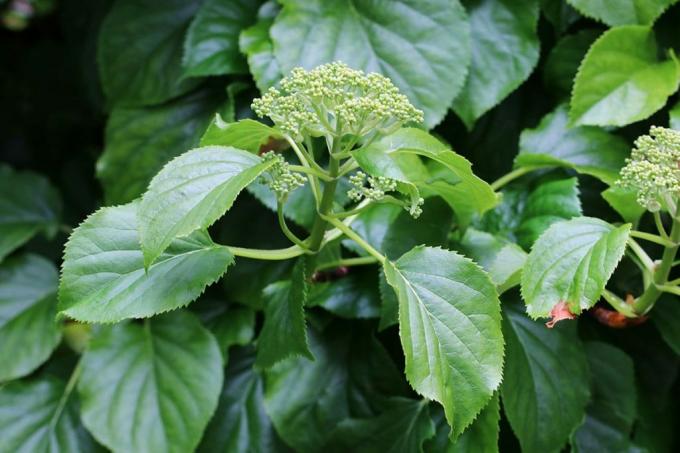
- strong and fast-growing creeper
- is considered an evergreen climber
- Growth height up to 1200 cm
- Leaves oval, dark green
- copper-red shoots
- blooming from July to September
- large white umbels
- grows on all garden soils
Note: This climbing hydrangea is generally considered to be evergreen. It keeps its foliage in mild winters. If it is colder, it can shed most of its leaves.
Climbing spindle bush (Euonymus fortunei)

- only this spindle bush is suitable as a climbing plant
- broadly bushy, climbing or covering the ground
- up to 100 cm high and wide
- Leaf oval, light green
- no autumn color, leaf green remains
- Flowering from May to June, inconspicuous
- decorative, coral-red fruits after flowering
Note: In early spring it may be advisable to cut the spindle bush into shape.
Climbing blackberry (Rubus henryi)
- creeping or climbing, forming runners
- partly thicket-like
- between 200 and 300 cm high
- Leaves deeply three-lobed or lanceolate, white tomentose underneath
- bright pink flowers in June
- black and red berries
- Ripening time from August, aromatic taste
Moon flower (ipomoea noctiflora)

- loops up to 600 cm in height
- the most magnificent of all morning glories
- Moonflower with brilliant white funnel-shaped petals
- Flowers open in the evening and at night
- reach a diameter of up to 15 cm
- Particularly intense fragrance in the evenings
- deep green, heart-shaped, long-stalked leaves, evergreen
- suitable for keeping in pots
Types from R - Z
Rose goblet / purple bell (Rhodochiton atrosanguineus)

- graceful evergreen climber usually cultivated as an annual
- can be overwintered
- strongly drooping petiole vine
- Leaves heart-shaped, evergreen
- perennial bloomer from May to October
- solitary, trumpet-shaped black-red flowers
- with a purple or pink chalice
Tuscan jasmine (Trachelospermum jasminoides)

- well branched, climbing shrub
- dense, bushy, upright
- up to 300 cm high and 150 cm wide
- Foliage oval and dark green
- flowers from May to September
- small, yellow, simple flowers
Flowering climbing plants
Types from A - E
American trumpet flower (Campsis radicans)

- perennial stick-root climber
- suitable for keeping in pots
- Height between 600 and 1200 cm
- Leaves medium green, imparipinnate
- blooms from July to September
- unfilled, trumpet-shaped flowers
- yellow, orange or red depending on the type
Note: The root area should have a cool and moist subsurface. Since this evergreen climbing plant blooms on the new wood, it has to be cut back to 15 cm every year.
Wisteria / wisteria (Wisteria sinensis)

- climbing and twining flowering shrub
- up to 900 cm high and 800 cm wide
- Flowers appear before the leaves
- around April / May
- beautiful fragrant flower clusters
- depending on the species in blue-violet, white or yellow
- between 20 and 70 cm tall
- light green, pinnate leaves, yellow autumn colors
Triple flower (bougainvillea)
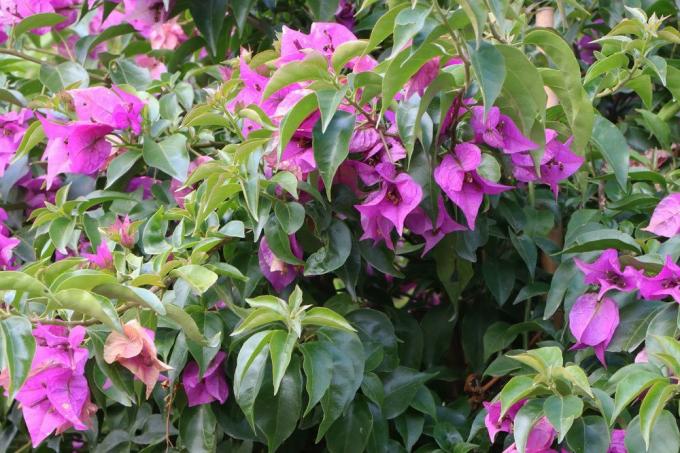
- one of the most magnificent climbing shrubs
- outdoor space from May to September
- countless bright purple, yellow-orange, pink or blood-red flowers
- three colored bracts surround the tubular flowers
- Cultivation only as a container plant
- frost-free overwintering required
- from October to winter quarters
Tip: After a slight pruning after the first flowering, young shoots with new florets form.
Types of F - H
Fire bean (Phaseolus coccineus)
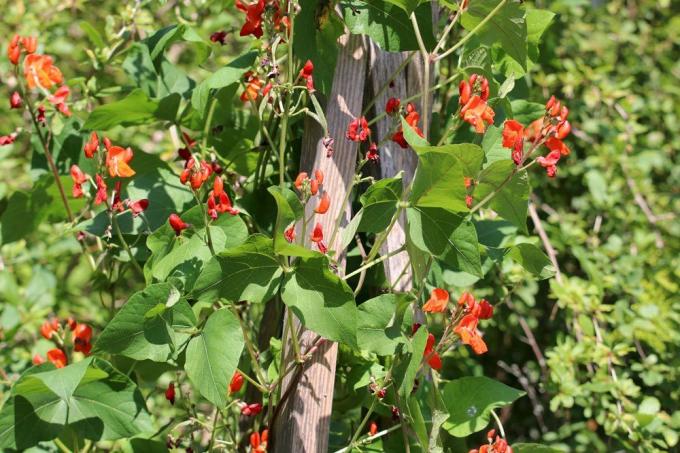
- annual herbaceous climbing plant
- up to 400 cm long spiral drives
- Climbing aid advisable
- blooming from June to September
- Depending on the variety, bright red, white or two-tone flowers
- six to ten pairs of flowers per inflorescence
- Raw beans are poisonous
- cooked a delicacy
Bottle gourd (Lagenaria siceraria)

- one of the oldest cultivated plants in the world
- annual, climbing or lying on the ground
- Main shoot up to 1000 cm in length
- leaves almost round, heart-shaped at the base
- Leaves and shoots smell of musk
- female and male flowers on a plant
- white, bell-shaped, from June
- only open in the evening
- about 100 cm long, spherical or bottle-shaped fruits
- The shell is thick and lignified
Tip: The fruits of the bottle gourd are extremely decorative. Young fruits are easy to shape as long as the skin has not hardened.
Bell vine (Cobaea scandens)
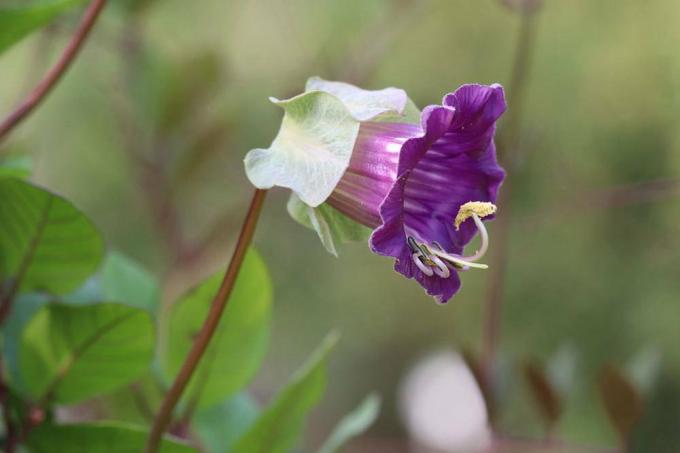
- fast-growing, perennial, herbaceous climber
- annual with heights of up to 400 cm
- pinnate leaves with smooth margins
- at the leaf ends, branched, reddish tendrils up to 5 cm long
- bend to the touch
- Flowering time from July to October
- large, pendulous, purple-blue bell flowers
- conspicuously protruding white stamens
Hops (humulus lupulus)
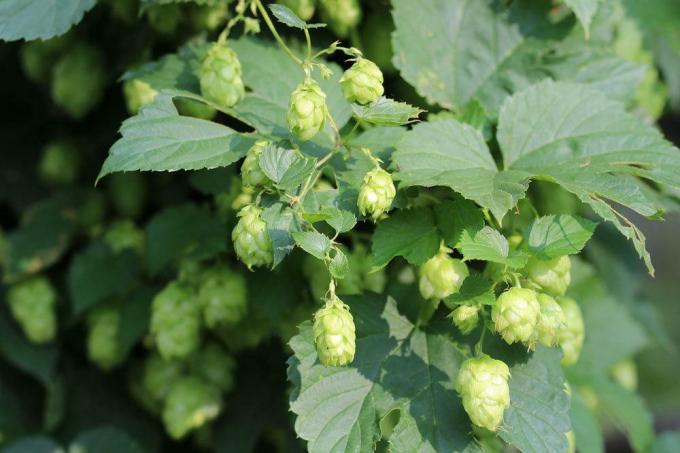
- vigorous, looping, partially runners
- grows 250 to 600 cm in height in one year
- dies above ground every winter
- green, lobed and ovate to round leaves, the edges of the leaves sawn
- blooming from July to August
- male flowers, inconspicuous greenish-yellow panicles
- female, decorative light green cones
- any plant, only male or female flowers
- Determine gender only at flowering
Types with K
Nasturtium (Tropaeolum majus)

- compact growth with tendrils up to three meters long
- medium strong growth
- in this country only one year
- bright permanent bloomer from June to November
- large red to yellow funnel-shaped flowers
- young leaves, flowers and buds edible
- Removal of wilted flowers promotes new flower flora
- Trellis an advantage
Climbing snapdragons (Asarina scandens / Asarina barclaiana)

- annual evergreen climber
- Asarina scandens and Asarina barclaiana are available in stores
- Asarina scandens more delicate and up to 200 cm high
- heart-shaped leaves more or less strong
- bald or sparsely hairy shoots
- bluish-red or purple pharynx-flowers with a white throat
- Asarina barclaiana up to 300 cm high
- shoots covered with hairs
- Asarina barclaiana flowers are intensely purple in color
- significantly brighter inside
- Flowering time from early summer to late autumn
- if kept for several years, frost-free wintering is necessary
Climbing roses

- Above average growth, up to 500 cm high
- weak and medium growing species
- profuse flowers
- don't take up much space
- Blossoms and a magical scent all summer long
- flowering once or several times
- different flower colors, filled or unfilled
- robust ADR roses and rambler roses are particularly recommended
- Climbing roses have to be blended
Knotweed (Fallopia baldschuanica)

- vigorous climbing plant
- Heights up to 1200 cm
- cannot do without a climbing aid
- oval, green leaves, shedding foliage
- blooms from July to September
- white, up to 20 cm long panicles of flowers
Tip: Fallopia baldschuanica should be cut back in winter.
Types from R - Z
Pink Trumpet Wine (Podranea ricasoliana)
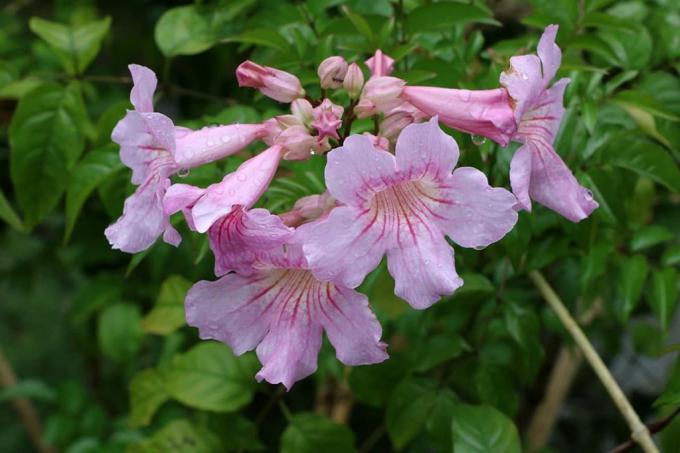
- Strong-growing, not hardy climber for keeping in a bucket
- Height between 150 and 400 cm
- inspires with beautiful flowers
- very large, bell- or trumpet-shaped and fragrant
- pink with dark red stripes
- dense, dark green, leathery foliage
- also very decorative outside of the flowering period
- requires frost-free wintering
Chocolate wine (Akebia quinata)

- Plant name refers to the fragrant flowers
- twisting, climbing growth up to 700 cm high
- Foliage evergreen in mild winters
- Flowering in May
- simple cup-shaped flowers
- violet brown (female) or pink (male)
- cucumber-shaped fruits pop open when ripe
- light purple and light green skin
- Jelly-like pulp, sweet in taste
- Sensitive to frost at a young age
tip: The pulp can be eaten raw or processed into delicious desserts.
Beautiful tendril (Eccremocarpus scaber)

- one of the most beautiful climbing plants
- richly branched network of slender shoots
- becomes 200-300 cm high
- Leaves pinnate unpaired, tendril, filigree
- abundant flowering from July to frost
- Flowers change color from yellow to red
- are bell-shaped very numerous
- ideal container plant, overwinter frost-free
Black-eyed Susan (Thunbergia alata)

- is one of the most popular annual climbing plants
- can climb to lofty heights or act as a ground cover
- Height between 120 and 150 cm
- dark green, triangular to heart-shaped leaves
- lush flowers from May to September
- yellow, orange or red flowers
- sharply outlined black throat
- can overwinter in a frost-free place
Winter jasmine (Jasminum nudiflorum)

- Loose growth, heavily overhanging
- as a small shrub or climbing plant
- Growth height up to 300 cm
- Leaves green, threefold, oval, lanceolate
- late flowering from December to March
- simple, bright yellow flowers
frequently asked Questions
Whether a climbing aid is needed depends on the type. Vigorous species such as wisteria or knotweed cannot do without climbing support. In contrast, so-called self-climbers such as ivy or wild wine need no climbing aid at all. For annual species, threads or wires stretched between bamboo sticks or hazelnut sticks are usually sufficient.
This is not a problem. The species in question should have the same demands on the location and, if possible, have to be cut at the same time. A good combination is, for example, the classic clematis with large shrub or rambler roses.
Partially. While self-climbing like ivy or wine can cause damage to the plaster, those that are prone to sooty mildew leave unsightly stains on the facade.



